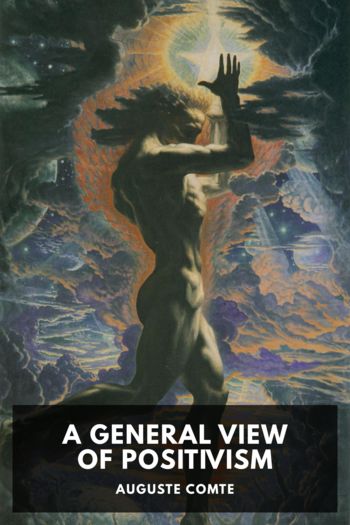A General View of Positivism - Auguste Comte (the snowy day read aloud TXT) 📗

- Author: Auguste Comte
Book online «A General View of Positivism - Auguste Comte (the snowy day read aloud TXT) 📗». Author Auguste Comte
The adoption of such measures would soon bring the Positivist Committee into favour. Many others might be suggested, relating directly to its fundamental purpose, which need not be specially mentioned here. I will only suggest the foundation, by voluntary effort, of an Occidental School, to serve as the nucleus of a true philosophic class. The students would ultimately enter the Positivist priesthood; they would in most instances come from the working class, without, however, excluding real talent from whatever quarter. By their agency the septennial course of Positive teaching might be introduced in all places disposed to receive it. They would besides supply voluntary missionaries, who would preach the doctrine everywhere, even outside the limits of Western Europe, according to the plan hereafter to be explained. The travels of Positivist workmen in the ordinary duties of their calling, would greatly facilitate this work.
A more detailed view of this provisional system of instruction will be found in the second edition of the Report on the Subject of a Positive School, published by the Positivist Society in 1849.18
There is another step which might be taken, relating not merely to the period of transition, but also to the normal state. A flag suitable to the Western Republic might be adopted, which, with slight alterations, would also be the flag for each nation. The want of such a symbol is already instinctively felt. What is wanted is a substitute for the old retrograde symbols, which yet shall avoid all subversive tendencies. It would be a suitable inauguration of the period of transition which we are now entering, if the colours and mottoes appropriate to the final state were adopted at its outset.
To speak first of the banner to be used in religious services. It should be painted on canvas. On one side the ground would be white; on it would be the symbol of Humanity, personified by a woman of thirty years of age, bearing her son in her arms. The other side would bear the religious formula of Positivists: “Love is our Principle, Order is our Basis, Progress our End,” upon a ground of green, the colour of hope, and therefore most suitable for emblems of the future.
Green, too, would be the colour of the political flag, common to the whole West. As it is intended to float freely, it does not admit of painting; but the carved image of Humanity might be placed at the banner-pole. The principal motto of Positivism will, in this case, be divided into two, both alike significant. One side of the flag will have the political and scientific motto, “Order and Progress”: the other, the moral and aesthetic motto, “Live for Others.” The first will be preferred by men; the other is more especially adapted to women, who are thus invited to participate in these public manifestations of social feeling.
This point settled, the question of the various national flags becomes easy. In these the centre might be green, and the national colours might be displayed on the border. Thus, in France, where the innovation will be first introduced, the border would be tricolour, with the present arrangement of colours, except that more space should be given to the white, in honour of our old royal flag. In this way uniformity would be combined with variety; and, moreover, it would be shown that the new feeling of Occidentality is perfectly compatible with respect for the smallest nationalities. Each would retain the old signs in combination with the common symbol. The same principle would apply to all emblems of minor importance.
The question of these symbols, of which I have spoken during the last two years in my weekly courses of lectures, illustrates the most immediate of the functions to which the Positive Committee will be called. I mention it here, as a type of its general action upon European society.
Without setting any limits to the gradual increase of the Association, it is desirable that the central nucleus should always remain limited to the original number of thirty-six, with two additions, which will shortly be mentioned. Each member might institute a more numerous association in his own country, and this again might be the parent of others. Associations thus affiliated may be developed to an unlimited extent; and thus we shall be able to maintain the unity and homogeneity of the Positive Church, without impairing its coherence and vigour. As soon as Positivism has gained in every country a sufficient number of voluntary adherents to constitute the preponderating section of the community, the regeneration of society is secured.
The numbers assigned above for the different nations, only represent the order in which the advanced minds in each will cooperate in the movement. The order in which the great body of each nation will join it, will be, as far as we can judge from their antecedents, somewhat different. The difference is, that Italy here takes the second place, and Spain the third, while England descends to the last. The grounds for this important modification are indicated in the third edition of my Positive Calendar. They will be discussed in detail in the fourth volume of this Treatise.19
From Europe the movement will spread ultimately to the whole race. But the first step in its progress will naturally be to the inhabitants of our colonies, who, though politically independent of Western Europe, still retain their filiation with it. Twelve colonial members may be added to the Council; four for each American Continent, two for India, two for the Dutch and Spanish possessions in the Indian Ocean.
This gives us forty-eight members. To these twelve foreign associates will gradually be added, to represent the populations whose growth has been retarded; and then the Council will have received its full complement. For every nation of the world is





Comments (0)